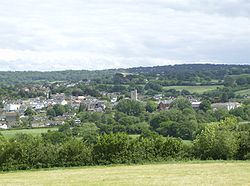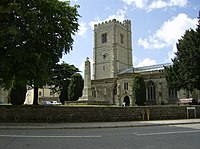Axminster
| Axminster | |
| Devon | |
|---|---|
 Axminster | |
| Location | |
| Grid reference: | SY2998 |
| Location: | 50°46’52"N, 3°0’0"W |
| Data | |
| Population: | 5,626 (2001) |
| Post town: | Axminster |
| Postcode: | EX13 |
| Dialling code: | 01297 |
| Local Government | |
| Council: | East Devon |
| Parliamentary constituency: |
Tiverton and Honiton |
Axminster is a market town in south-eastern Devon, some 28 miles from the county town (Exeter) and lying against the border with Dorset. The town is built on a hill overlooking the River Axe which flows down to enter the English Channel at Axmouth. At the 2001 census, Axminster had a population of 5,626.
It is a market town and the market is still held every Thursday.
Axminster is best known for giving its name to the Axminster carpet. An Axminster-type power loom is capable of weaving high quality carpets with many varying colours and patterns. While Axminster carpet is made in the town of Axminster, this type of carpet is now manufactured all over the world.
Contents
History
The town may date back to the early Iron Age of around 300 BC. It lies on two major Roman roads: the Fosse Way from Lincoln to Seaton, and the Dorchester to Exeter road. There was a Roman fort on the crossroads at Woodbury Farm, just south of the present town.
Axminster was recorded in the late 9th century as Ascanmynster and in the Domesday Book of 1086 as Aixeministra. The name means "monastery by the River Axe". The river name Axe has origins in the ancient British language, or even earlier, and appears to be a variant on the many Esk names.
In 1210, a charter was granted to the town that included the right to hold a weekly cattle market which took place in the market square until it was moved to Trinity Square in 1834. It then moved in October 1912 to a site off South Street where it was held for 94 years. It finally closed in 2006 in the aftermath of the 2001 foot-and-mouth outbreak.[1] A building on the site then continued to be used for a general auction until all the buildings were demolished and replaced by a housing development.
The modern history of the town is very much linked to the carpet industry, started by Thomas Whitty at Court House near the church in 1755. The completion of the early hand-tufted carpets was marked by a peal of bells from the parish church as it took a great amount of time and labour to complete them.
The town was on the coaching route from London to Exeter. In 1760 a coaching inn named The George Hotel was opened on the corner of Lyme Street and Chard Street on the site of an old inn called the Cross Keys that was destroyed by fire in 1759. Over sixteen coaches a day would stop at the hotel in its heyday for refreshments and to change horses, the building still stands but it is currently unoccupied.[1] Axminster was on the route of The Trafalgar Way which is the name given to the historic route used to carry dispatches with the news of the Battle of Trafalgar overland from Falmouth to the Admiralty in London in 1805 and there is a plaque commemorating this fact in the town centre.
Axminster railway station was opened on 19 July 1860, with the London and South Western Railway offering direct services between Queen Street Station in Exeter and Yeovil. The station building was designed by the railway’s architect, Sir William Tite, in mock Gothic style. In 1903, the branch line from Axminster to Lyme Regis was opened. This branch line was closed with the Beeching Axe, in the 1960s. One engine has been preserved on the Bluebell Line, in Sussex, while the station was dismantled and reconstructed at New Alresford, on the Watercress Line in Hampshire.
Axminster is the southern starting point of the Taunton Stop Line, a Second World War defensive line consisting of pillboxes and anti-tank obstacles, which runs north to the Somerset coast near Highbridge.[2]
Sights of the town
 Axminster Museum
Axminster Museum Blackdown Hills Area of Outstanding Natural Beauty
Blackdown Hills Area of Outstanding Natural Beauty East Devon AONB
East Devon AONB East Devon Way
East Devon Way Forde Abbey
Forde Abbey Jurassic Coast
Jurassic Coast Lambert's Castle
Lambert's Castle
 Loughwood Meeting House
Loughwood Meeting House Musbury Castle
Musbury Castle
 Shute Barton
Shute Barton
Things near the town
Nearby Kilmington was used as a location for the 1998 LWT adaptation of Tess of the d'Urbervilles. The celebrity chef and TV presenter Hugh Fearnley-Whittingstall has his River Cottage H.Q. at a 60-acre farm in the Axe valley. He has since purchased an old inn that once provided the ballroom of the town, now converted to an organic produce shop/market and canteen[3] .
Leisure facilities and shops
The town has Cloakham Lawns, the Axe Valley Sports Centre and Flamingo Swimming Pool, a library, several churches and a museum of local history. Shops include two supermarkets, a small department store, Trinity House, and several independent retailers.
The Guidhall is a theatre with meeting rooms that hosts many events and clubs such as Axminster Drama Club and Axminster Operatic Society.
Outside links
| ("Wikimedia Commons" has material about Axminster) |
References
- ↑ 1.0 1.1 Historical Axminster Rotary Club Blue Plaques
- ↑ "Land off Morton Way, Axminster, Devon – A Limited Archaeological Excavation and Recording Programme" (pdf). Archaeology Data Service. Context One Archaeological Services 2010. 2010. http://archaeologydataservice.ac.uk/catalogue/adsdata/oasis_reports/contexto1/ahds/dissemination/pdf/contexto1-73825_1.pdf. Retrieved 14 May 2011.
- ↑ "Views are the jewels in Devon’s crown". Portsmouth News. 17 November 2012. http://www.portsmouth.co.uk/lifestyle/tn2-saturday/get-away/views-are-the-jewels-in-devon-s-crown-1-4495043. Retrieved 18 November 2012.
- Mee, A. The King's England:Devon (Hodder and Stoughton, 1965); p. 25–26.
- Mills, A. D. Dictionary of English Place-Names. Oxford University Press. ISBN 0-19-280074-4
